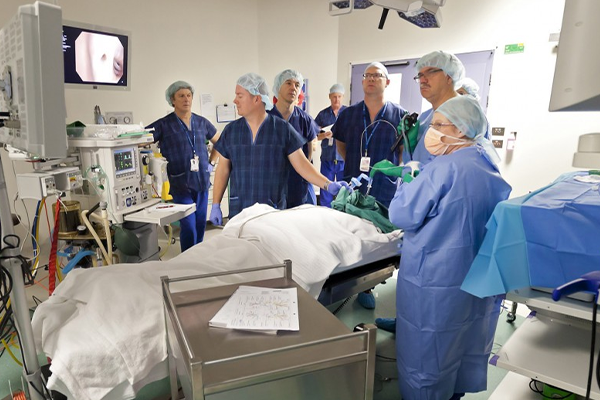
Associate Professor David Langton is researching ways to further develop a procedure for severe asthmatics. (Photo taken in 2014)
A relatively new procedure which eases coughing and wheezing in severe asthmatics could soon be made more effective thanks to research being led by Peninsula Health.
Associate Professor David Langton, Director of Thoracic Medicine at Peninsula Health, is leading a joint study into bronchial thermoplasty with researchers from the University of Western Australia and the University of Auckland. The research has been funded with a one million dollar National Health and Medical Research Council Ideas Grant (NHMRC).
“The procedure gaining acceptance as a result of what we’ve been doing over the last five years,” says A/Prof Langton.
“Our hope is to find a better way of choosing patients for bronchial thermoplasty, so that no patient has to go through an unsuccessful procedure.”
A/Prof Langton carried out the procedure for the first time in Victoria on a patient at Frankston Hospital in 2014.

A/Prof Langton is among only a few specialists in Australia who currently perform the bronchial thermoplasty.
Usually, this approach is reserved for asthmatics where other therapies are not working effectively.
The surgical procedure involves the insertion of a thin probe into the lungs. This sends out radiofrequency signals which heat, and ultimately weaken smooth muscle tissue, found in layers around bronchial tubes.
It’s this muscle tissue which constricts during an asthma attack.
By carrying out multiple sessions of this technique, airways can be opened up, allowing people with asthma to have more control over their breathing.

A/Prof Langton says the procedure reduces the effects of asthma attacks on chronic asthma sufferers for whom traditional medications do not work.
“More than 50 patients have undergone this procedure now, with an 85 per cent success rate,” says A/Prof Langton.
“The majority of patients are getting better, but not everybody.”
A/Prof Langton is the lead investigator of the NHMRC Grant, which aims to develop and refine imaging techniques, namely Optical Coherence Tomography, to better highlight which components of the tissue layer are muscle and which are not.
“Once we can accurately identify which is the muscle within the wall, then we can measure it. Then we may be able to know whether to only treat patients whose airways have particularly thick muscle.
“The idea is to use new imaging techniques to try to work out which patients are the ones most likely to benefit, and the patients least likely to benefit.”
The study will also investigate the use of a different kind of Magnetic Resonance Imaging (MRI) to image the lung, with the help of Monash University and Peninsula Health patients, before and after bronchial thermoplasty.
“We’ve got MRI on the Peninsula, but lungs don’t show up with an MRI, because air isn’t magnetised.
“To make the air in the lungs show up, you need to do something to the air. That involves making a special sort of gas mixture, which is not radioactive, but which is able to be magnetised. They can do that at Monash University, in the Synchrotron.”
David and the team’s aim is to then image in a way that shows the distribution of air within the lung, before and after the procedure. They hope the findings will allow physicians to better identify when the treatment will be effective and for which patients.
The project is due to begin in 2020 and is set to be carried out over five years.